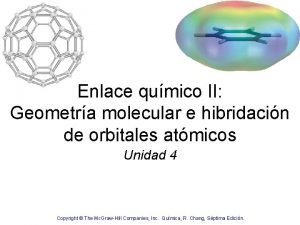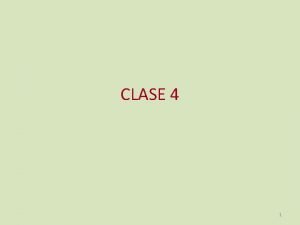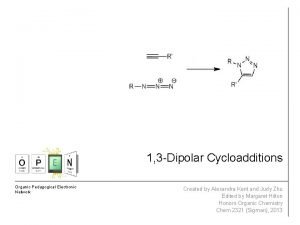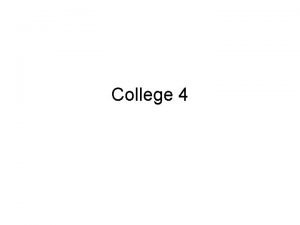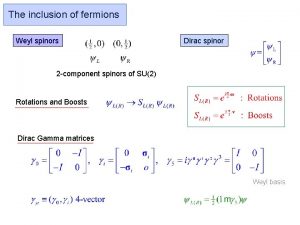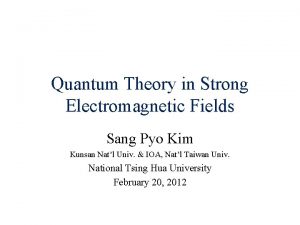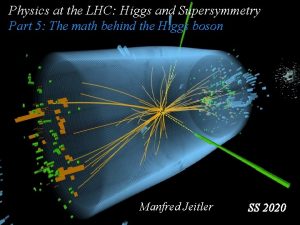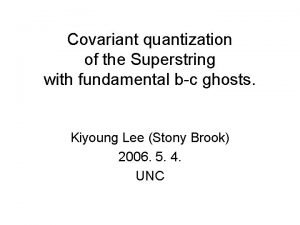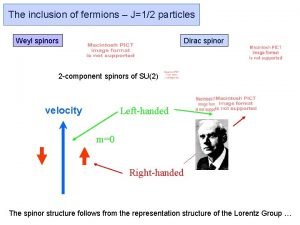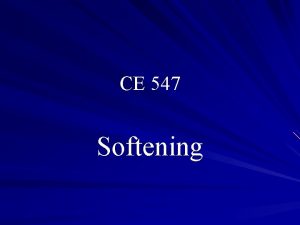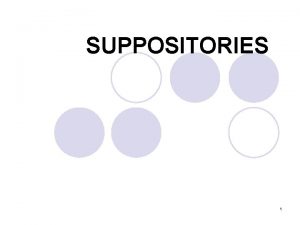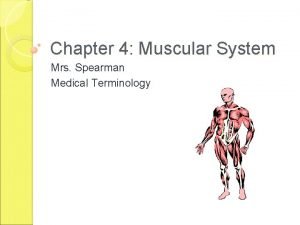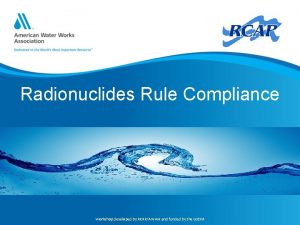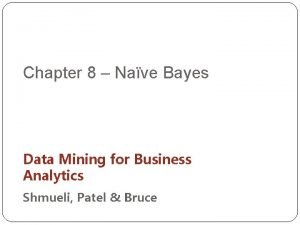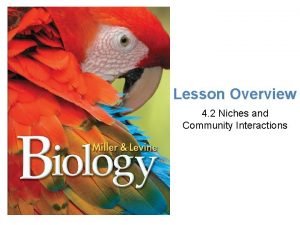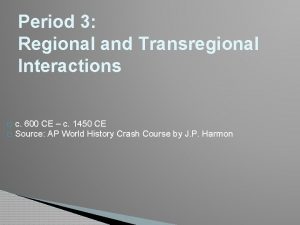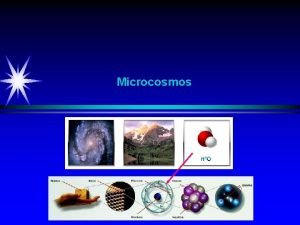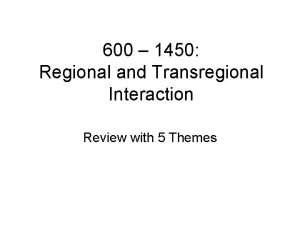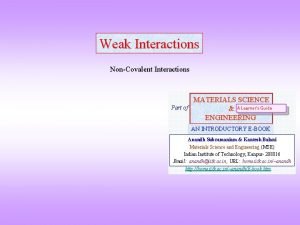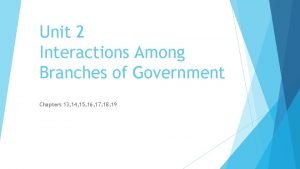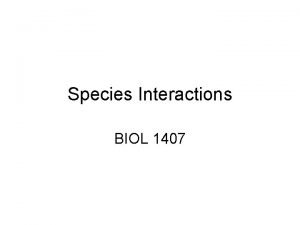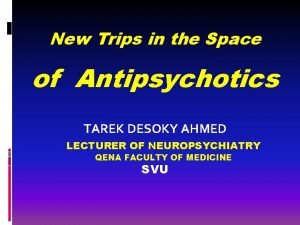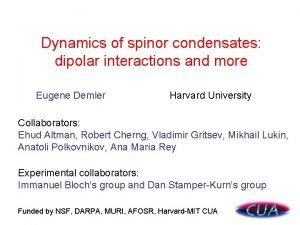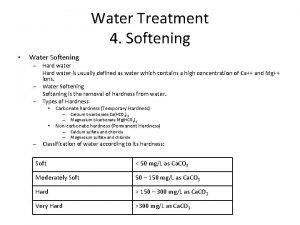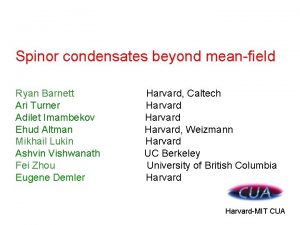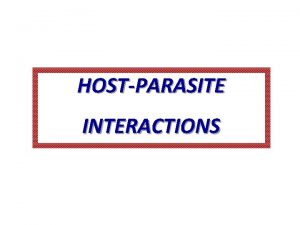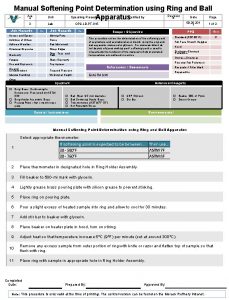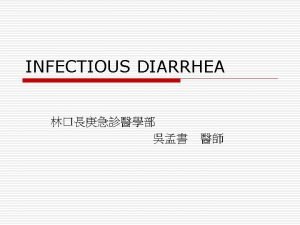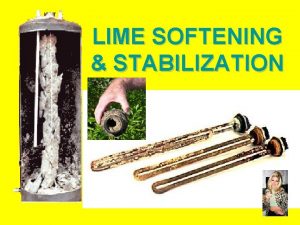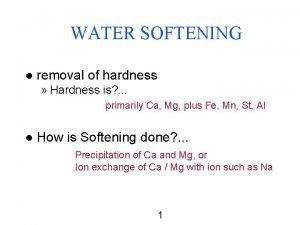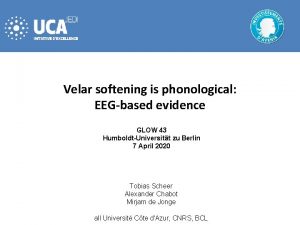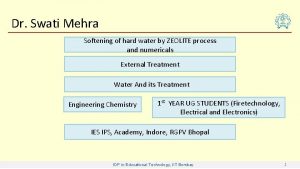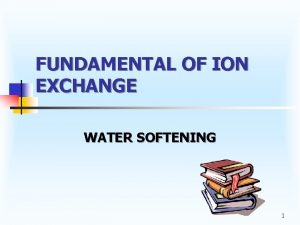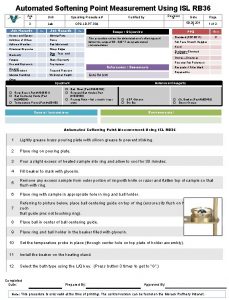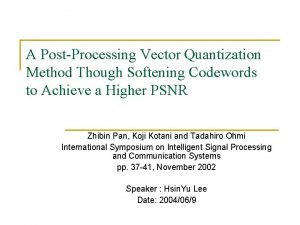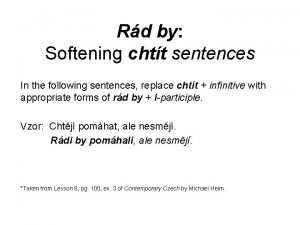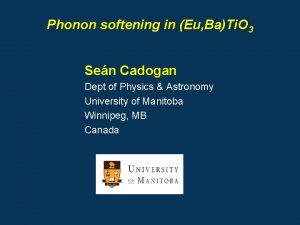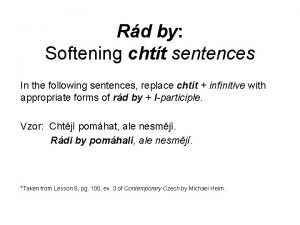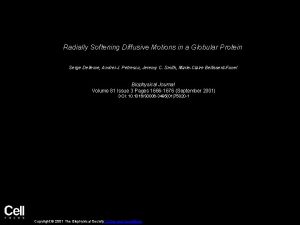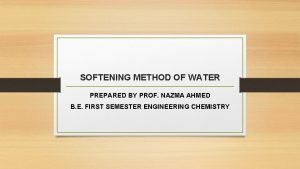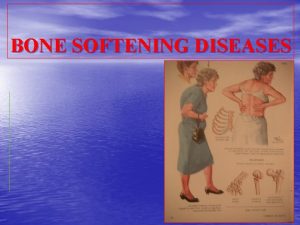Dipolar interactions and magnetoroton softening in spinor condensates







































- Slides: 39

Dipolar interactions and magnetoroton softening in spinor condensates Robert Cherng, Eugene Demler Harvard University Collaborators: Vladimir Gritsev (Univ. Frieburg) Dan Stamper-Kurn (UC Berkeley) Funded by NSF, DARPA, MURI, AFOSR, Harvard-MIT CUA

Outline Introduction. Roton softening and supersolids Magnetic dipolar interactions in spinor condensates. Averaging over Larmor precession Instabilities. Qualitative picture and analysis of Bogoliubov modes Berkeley experiments. Spontaneously modulated textures in spinor condensates


Possible supersolid phase in 4 He Phase diagram of 4 He A. F. Andreev and I. M. Lifshits (1969): Melting of vacancies in a crystal due to strong quantum fluctuations. Also G. Chester (1970); A. J. Leggett (1970) T. Schneider and C. P. Enz (1971). Formation of the supersolid phase due to softening of roton excitations

Interlayer coherence in bilayer quantum Hall systems at n=1 Hartree-Fock predicts roton softening and transition into a state with both interlayer coherence and stripe order. Transport experiments suggest first order transition into a compressible state. Eisenstein, Boebinger et al. (1994) L. Brey and H. Fertig (2000)

Roton spectrum in pancake polar condensates Santos, Shlyapnikov, Lewenstein (2000) Fischer (2006) Origin of roton softening Repulsion at long distances Attraction at short distances Stability of the supersolid phase is a subject of debate

Magnetic dipolar interactions in spinor condensates q Comparison of contact and dipolar interactions. Typical value a=100 a. B For 87 Rb m=m. B and e=0. 007 e=0. 16 Bose condensation of 52 Cr. T. Pfau et al. (2005) Review: Menotti et al. , ar. Xiv 0711. 3422 For 52 Cr m=6 m. B and

Magnetic dipolar interactions in spinor condensates Interaction of F=1 atoms Ferromagnetic Interactions for 87 Rb a 2 -a 0= -1. 07 a. B A. Widera, I. Bloch et al. , New J. Phys. 8: 152 (2006) Spin-depenent part of the interaction is small. Dipolar interaction may be important (D. Stamper-Kurn)

Spontaneously modulated textures in spinor condensates Vengalattore et al. PRL (2008) Fourier spectrum of the fragmented condensate

This talk: Instabilities of F=1 spinor condensates due to dipolar interactions. New phenomena due to averaging over Larmor precession Theory: unstable modes in the regime corresponding to Berkeley experiments Results of Berkeley experiments Earlier theoretical work on dipolar interactions in spinor condensates: Meystre et al. (2002), Ueda et. al. (2006), Lamacraft (2007). New phenomena: interplay of finite transverse size and dipolar interaction in the presence of fast Larmor precession

Dipolar interactions after averaging over Larmor precession

Energy scales Magnetic Field • Larmor Precession (100 k. Hz) • Quadratic Zeeman (0 -20 Hz) S-wave Scattering • Spin independent (g 0 n = k. Hz) • Spin dependent (gsn = 10 Hz) Dipolar Interaction • Anisotropic (gdn=10 Hz) • Long-ranged Reduced Dimensionality • Quasi-2 D geometry B F

Dipolar interactions Static interaction z parallel to is preferred “Head to tail” component dominates Averaging over Larmor precession perpendicular to is preferred. “Head to tail” component is averaged with the “side by side”

Instabilities: qualitative picture

Stability of systems with static dipolar interactions Ferromagnetic configuration is robust against small perturbations. Any rotation of the spins conflicts with the “head to tail” arrangement Large fluctuation required to reach a lower energy configuration

Dipolar interaction averaged after precession “Head to tail” order of the transverse spin components is violated by precession. Only need to check whether spins are parallel XY components of the spins can lower the energy using modulation along z. X X Z components of the spins can lower the energy using modulation along x Strong instabilities of systems with dipolar interactions after averaging over precession

Instabilities: technical details

Hamiltonian Non-interacting part Quadratic Zeeman Interactions contact density dipolar contact spin

Precessional and Quasi-2 D Averaging Rotating Frame + Gaussian profile Quasi-2 D Time Averaged Dipolar Interaction

Effective Interaction after averaging Magnetization perpendicular to B Magnetization parallel to B • There always unstable directions • |k| singularity Unstable modes determined by competition of interaction and kinetic energy For Berkeley expts l around 30 mm

Collective Modes Mean Field Equations of Motion Collective Fluctuations (Spin, Charge) δf. B δn δη Ψ 0 δφ Spin Mode δf. B – longitudinal magnetization δφ – transverse orientation Charge Mode δn – 2 D density δη – global phase

Instabilities of collective modes Q measures the strength of quadratic Zeeman effect

Berkeley Experiments: checkerboard phase

Berkeley Experiments: checkerboard phase M. Vengalattore, et. al, PRL 100: 170403 (2008)

Instabilities of collective modes

Conclusions • Dipolar interactions crucial for spinor condensates… • But effectively modified by quasi-2 D and precession • Variety of instabilities (ring, stripe, checkerboard) • But what about the ground state?

Instabilities of the spiral state Adiabatic limit Sudden limit

Mean-field energy Inflection point suggests instability Negative value of shows that the system can lower its energy by making a non-uniform spiral winding Uniform spiral Non-uniform spiral

Nature of transitons and ordered phases





Effects of spiral winding

Supersolid in 4 He A. F. Andreev and I. M. Lifshits, Sov. Phys. JETP 29, 1107 (1969) Melting of vacancies in a crystal due to strong quantum fluctuations

Supersolid phase in 4 He Phase diagram of 4 He A. F. Andreev and I. M. Lifshits, Sov. Phys. JETP 29, 1107 Melting of vacancies in a crystal due to strong quantum fluctuations

Nature of transiton and ordered phases

Phases of bilayer quantum Hall systems at n=1 and roton softening Raman scattering Pellegrini, Pinczuk et al. (2004) Roton softening and sharpening observed in Raman experiments. This is in conflict with transport measurements

Instabilities of F=1 spinor condensates due to dipolar interactions and roton softening Earlier theoretical work on dipolar interactions in spinor condensates: Meystre et al. (2002), Ueda et. al. (2006), Lamacraft (2007). New phenomena: interplay of finite transverse size and dipolar interaction in the presence of fast Larmor precession
 Interacciones moleculares
Interacciones moleculares Dipolona
Dipolona Dipolar
Dipolar Dipolar bond
Dipolar bond Weyl spinors
Weyl spinors Spinor
Spinor Spinor
Spinor Spinor
Spinor Dirac spinor
Dirac spinor Caustic embrittlement
Caustic embrittlement Lime soda process of water softening
Lime soda process of water softening Split treatment water softening
Split treatment water softening Brittleness of suppositories is measured by
Brittleness of suppositories is measured by Dyskinesia is the distortion or impairment of:
Dyskinesia is the distortion or impairment of: Lime softening
Lime softening Chapter 26 pedicuring test answers
Chapter 26 pedicuring test answers Interactions between ais and internal and external parties
Interactions between ais and internal and external parties Narrative report with contextual description
Narrative report with contextual description Contractory monetary policy
Contractory monetary policy Properties and interactions of magnets
Properties and interactions of magnets Geosphere examples
Geosphere examples Chapter 6 lesson 1 habitats niches and species interactions
Chapter 6 lesson 1 habitats niches and species interactions Integral architecture example
Integral architecture example Factors influencing the communication
Factors influencing the communication Symbiosis and species interactions keystone webquest
Symbiosis and species interactions keystone webquest Naive bayes pays attention to complex interactions and
Naive bayes pays attention to complex interactions and Integral vs modular architecture
Integral vs modular architecture Niches and community interactions
Niches and community interactions Regional and transregional interactions
Regional and transregional interactions Microcosmos macrocosmos
Microcosmos macrocosmos Regional and transregional interactions
Regional and transregional interactions Noncovalent interactions
Noncovalent interactions Interactions among branches of government
Interactions among branches of government 5 types of symbiosis
5 types of symbiosis Parasitism
Parasitism Sertraline interactions
Sertraline interactions Grapefruit-drug interactions chart
Grapefruit-drug interactions chart Interactions in the environment grade 7
Interactions in the environment grade 7 What is abiotic factor
What is abiotic factor Section 20-1 review species interactions
Section 20-1 review species interactions
